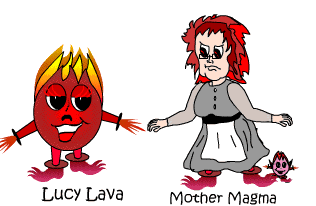BACKGROUND:
 The Plate Tectonic Cycle focuses on how data from
volcanoes and earthquakes helps us to understand the Earth. Children are
fascinated with this subject, mainly because of what we call the
"disaster factor." Disasters of all kinds seem to captivate
children's attention, especially those with death and destruction. Plate
Tectonics is a subject with all these factors. As a teacher tells stories,
we have found that students will remember a specific volcano or earthquake
more if you include how many people died, how they died, and a visual look
at the extent of the disaster without bodies. The Plate Tectonic Cycle focuses on how data from
volcanoes and earthquakes helps us to understand the Earth. Children are
fascinated with this subject, mainly because of what we call the
"disaster factor." Disasters of all kinds seem to captivate
children's attention, especially those with death and destruction. Plate
Tectonics is a subject with all these factors. As a teacher tells stories,
we have found that students will remember a specific volcano or earthquake
more if you include how many people died, how they died, and a visual look
at the extent of the disaster without bodies.
Volcanoes form when molten rock, created inside the
crust or upper mantle of the Earth, moves upward and erupts on the Earth’s
surface. Molten rock is less dense than the surrounding rock, so it is
buoyant and rises, just like hot air. Each eruption can produce layers of
lava that will later become volcanic rock. These layers build the volcano.
Depending on how viscous the lava is will depend on the shape. The
word "viscous" is explained in the storybook called "Lucy
Lava."
Volcanoes have several shapes, which are controlled by
the composition of the magma and the nature of its eruption. If a volcano
produces very fluid lava (low in the compound SiO2, or silica),
the magma flows a long distance before it cools, making a flat,
shield-shaped volcano. If the volcano produces very sticky magma (high in
silica) it tends to have an explosive eruptive style that includes lava,
pyroclastic flows, and ash. This material piles up right around the volcano,
forming a steep cone, a classic volcano shape. Volcanoes that are a built
from ash and cinders usually have steep sides, but tend to erode quicker
than volcanoes built from lava.
PROCEDURE:
- Review that a) all mountains are not volcanoes and
b) volcanoes produce one type of igneous rock (volcanic rocks). Students
will learn that all volcanoes have just a few shapes, and volcanoes grow
from the inside outward. Ask students if they have ever seen a round
volcano (they should answer no).
- Read students the storybook "Lucy
Lava." You may want students to read each of the pages.
Make sure that students understand some of the analogs. Question
the students at all times to make sure they understand the words.
Use the frame on "viscous" to illustrate how slow a viscous
layer takes to spread.
- Show students pictures or videos of volcanoes. You may use
the pictures enclosed or pictures of volcanoes. Display them for your
students, so that they can see the many different types of eruptions and
shapes of volcanoes. You may want to glue them on tag board, so that you
can display them for the next few weeks. If you don't have access to
pictures, use library books or the Internet. You may want to tell
students where the volcanoes are from, and locate them on a world map or
a globe. Here are some recommended websites
http://www.geo.mtu.edu/volcanoes/
University of Michigan volcano sites around the world.
http://www.usgs.gov
On their search, type in volcano.
- Draw the shapes below on the board.

Ask the students which shapes a volcano can take. Ask
them why only A, B, and F can be real volcanoes. Discuss that lava can be a
thick (viscous) liquid (like honey) or it can be very fluid like water, and
that this is the main control on the shape of a volcano. You may say that
the thickness (viscosity) of the lava depends on what chemical composition
(ingredients) the lava is made of, and how hot the lava is when it erupts at
the surface. When it comes out of the ground it flows and builds a
mountain-shaped structure. The thicker (more viscous) the lava the more
mountain-like it is, like in A and F. Examples include Mt. St. Helens and
Mt. Lassen. The thinner (less viscous) the lava, the more the mountain will
look like B. An example would be one of the Hawaiian volcanoes. The shape of
a volcano is also determined by gravity, and the stability of the walls of
the existing volcano.
Students do not need to understand the why or how
volcanoes have different shapes, just that there are just a few
characteristic shapes of a volcano. During the lab the students will
experiment with different types of shapes from different viscosities.
|